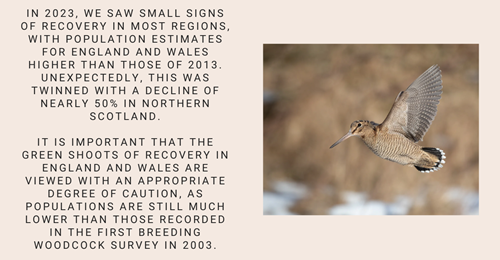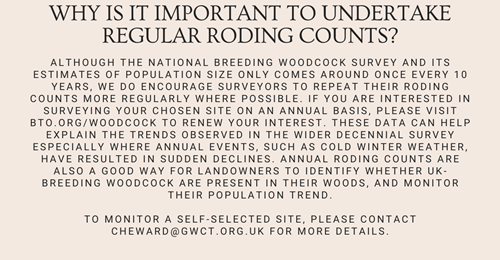Article written for Gamewise Spring 2024 by Chris Heward, Head of Wetland Research. He is keen to build an accurate picture of our woodcock population.
Chris Heward reports on a fantastic response to the 2023 Breeding Woodcock Survey and despite the conclusions not being straightforward, the results will help inform future woodcock conservation and policy.
You may recall reading a Gamewise article last spring, encouraging GWCT members to take part in the 2023 GWCT/BTO Breeding Woodcock Survey, and asking them to help make this ‘the biggest and most accurate assessment of Britain’s woodcock population to date’. One year on, and I’m pleased to report that we have done exactly that, with participation in 2023 far exceeding the expectations set by previous versions of the survey. Where the 2003 and 2013 surveys each provided data from approximately 800 randomly selected sites across Britain, in 2023, coverage increased to an impressive 1,192 sites, with an additional 38 sites surveyed in Northern Ireland. This survey, a collaboration with the British Trust for Ornithology (BTO), is reliant on volunteer surveyors and we are grateful to everyone who has helped make the 2023 survey such a success.
For the surveyors who were lucky enough to witness it, I hope the opportunity to observe the woodcock’s unusual roding behaviour was a suitable reward for your efforts. These distinctive display flights are used by male woodcock to attract the attention of females that gather in woodland clearings below. If sufficiently impressed, the female will signal her approval to a suitor with a flash of her white-tipped tail. It’s this unique display that forms the basis for our specially designed survey method. A human observer can find a suitable clearing, and by counting woodcock sightings during a 75-minute survey period, gather data that allows us to estimate local woodcock numbers.

Unfortunately, not all surveyors encountered roding woodcock, but for us these zero counts are equally important. We scale up local density estimates to form regional estimates of population size, and to do this, we need to know at what proportion of sites woodcock are present. Failing to gather a representative number of zero counts would exaggerate presence vs. absence, and falsely inflate our population estimates. For the many surveyors who did not see woodcock, I hope that the other interesting sights and sounds of our UK woodlands provided their own reward – and that the midges weren’t too persistent.
Woodcock numbers vary between regions: 73% of surveyors recorded woodcock in north-east England, compared with only 13% in Wales and south-west England. Understandably, woodcock abundance also varies in relation to the wooded area at a site. To account for this, we split our national sample into 12 regional categories, and then split each of them again into four subcategories based on the area of woodland. We separately estimate the woodcock population for each of these 48 ‘strata’ first, and combine their totals to produce a national population estimate.
Hopefully, this explains why maximising survey participation has become such a fixation. We scientists can be a bit of a bore when it comes to things like sample sizes, and it is reasonable to ask ‘why coverage at 1,200 sites is so much more worthwhile than the 800 visited in the previous surveys?’ But if you imagine that large sample broken down into 48 small categories, some of them representing remote, hard-to-survey regions where there are few local surveyors, you start to see how the sample size rapidly diminishes.
In 2023, we managed to address this precisely as we had hoped, with proportionally better coverage in Wales, Scotland, and northern England. The latter two are particularly important regions as these are areas that hold large proportions of the British resident population. Achieving this took a huge collaborative effort, and as well as the BTO, we drew upon the help of other organisations like the British Association for Shooting and Conservation (BASC) and Forestry and Land Scotland (FLS) to contact potential surveyors in areas where coverage had previously lacked.

2023 Breeding Woodcock Survey
Naturally, the question now is what did the 2023 survey actually show? The conclusions are not necessarily straightforward. The British woodcock population, overall, has continued to decline, but the -8% recorded between 2013 and 2023, is less severe than the -29% seen between 2003 and 2013. But this statement hides more complicated underlying patterns, as regional trends vary, and not in the ways we might have predicted given the previous surveys’ results.
Between 2003 and 2013, woodcock numbers fell in all parts of Britain, with the only exception being in northern Scotland where numbers remained large and stable. In 2023, we saw small signs of recovery in most regions, with population estimates for England and Wales higher than those of 2013. Unexpectedly, this was twinned with a decline of nearly 50% in northern Scotland which, considering the large proportion of the national population that this region holds, was enough of a reduction to completely overshadow increases elsewhere. Understanding precisely what has caused this apparent reversal in trends has become our next priority, but it is hoped that the 2023 survey data will hold the answers. It is possible that rising and falling woodcock populations are responding to patterns in woodland planting – the timing of which has differed in Scotland, England and Wales over the last half-century – and that analysis of woodcock population data alongside national records of woodland management can help shed light on this. It is also important that the green shoots of recovery in England and Wales are viewed with an appropriate degree of caution, as populations are still much lower than those recorded in the first Breeding Woodcock Survey in 2003. How the uptake of GWCT advice, issued in 2017 and designed to minimise the impact of shooting on our small resident population, might have benefited woodcock remains to be examined.
In Northern Ireland, we estimate that the breeding population consists of about 1,000 male woodcock: roughly 2% of the UK population. Most of these were found in the west of the region in Co. Fermanagh and Co. Tyrone. BASC helped make this Northern Irish population estimate possible by funding a regional organiser who could enlist and train surveyors there. Despite an attempt in 2013, this is the first time we have gathered data from enough sites to estimate the Northern Irish breeding woodcock population, and so as of yet, there is no opportunity to assess population change.